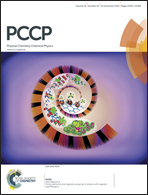Enhanced photoelectrochemical performance by synthesizing CdS decorated reduced TiO2 nanotube arrays†
Abstract
The efficient utilization of solar spectrum and photo-induced charge transport are critical aspects in improving the light conversion efficiency of solar cells and hydrogen generation. In this work, reduced TiO2 nanotube arrays with CdS decoration were fabricated through the simple cathodic polarization of annealed TiO2 nanotube arrays followed by the chemical deposition of CdS nanoparticles. Scanning electron microscopy (SEM), X-ray diffraction (XRD) and Raman spectroscopy confirmed the successful fabrication of the target material. UV-visible diffuse reflectance spectra showed a Burstein–Moss shift for reduced TiO2 NTs and a red shift of the absorption edge towards ca. 563 nm for CdS-decorated R-TiO2 NTs. Cyclic voltammetry and impedance spectra together demonstrate the decreased charge transport resistance for reduced TiO2 NTs. Under the excitation of monochromatic light at 420 nm, the proposed CdS-decorated reduced TiO2 NTs exhibit the maximum IPCE value of 30.12% in 1 M Na2SO3 electrolyte, which is almost twice higher than that achieved on CdS-decorated pristine TiO2 NTs. Therefore, the results here highlight the significance of charge transport in the light conversion process. The enhanced charge transport properties are ascribed to the increased number of electrons, which is brought about by the lattice oxygen vacancies (Ti3+) during the cathodic polarization.


 Please wait while we load your content...
Please wait while we load your content...